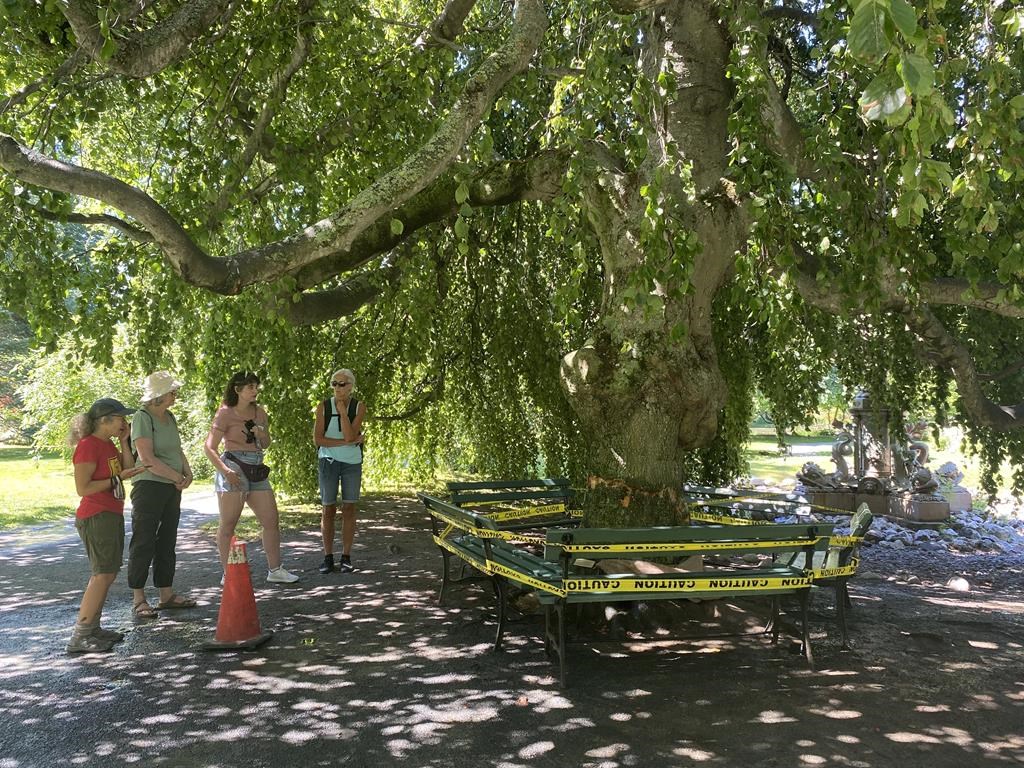In the heart of downtown Halifax sits a small but beloved park known for its elaborate flower beds and stately trees.

For more than 150 years, the Halifax Public Gardens have provided a quiet refuge for visitors and a pristine backdrop for countless weddings and graduations.
Just over a year ago, however, the park was left badly scarred after vandals scaled its wrought iron fences in the middle of the night. They used an axe to hack away at more than two dozen trees, some of them more than 200 years old.
“You would think that a place that gives people so much joy and relaxation, that nobody would want to harm the gardens,” Judith Cabrita, chairperson of the non-profit Friends of the Public Gardens, said in an interview this week. “To have the trees being attacked was like a personal attack for many people.”
Sean Street, a horticulture supervisor with the Halifax Regional Municipality, said the initial prognosis for the damaged trees looked grim. In all, 33 were damaged. Three of them — mostly smaller trees — had to be cut down.
“It was a very dark time last July when we were in there,” he said during a recent lecture at Saint Mary’s University in Halifax. “We were really uncertain about how many trees we were going to lose.”
But in the past 12 months, something remarkable has happened.

Get daily National news
In the spring, all of the survivors “leafed out,” meaning they showed signs of vigorous growth as staff at the park and outside experts tended to their wounds.
Most of the larger, older trees have significant energy reserves to draw on, Street said, but some of the smaller trees are having a difficult time. “I can tell you that we’re going to lose more,” he said, adding that it could take years before the full extent of the damage is known.
Still, there are many signs of hope. A small toba hawthorn, so badly harmed it was supposed to be cut down, has sprouted a sucker branch off its main trunk and appears to be thriving. “It came back to life,” Street said. “It looks amazing.”
Many of the trees have been patched with coconut fibres wrapped in burlap. And some of the larger trees already have “wound wood”
growing in the spaces where bark used to be.
“This is a best-case scenario for us,” Street said. “It’s the best thing we could have hoped for.”
One of the largest trees in the park, a massive London plane tree estimated to be 150 years old, appears to be healing on it own. Its wounds are already closing over. “It almost looks like it healed like an animal would heal,” Street said. “Its canopy is really coming in.”
Other trees have been mended with intricate bridge grafts, which means small branches are affixed and act like straws to carry nutrients past the injured area. Stan Kochanoff, an ornamental horticulture expert, has been working on some of the grafting. “I think most of the trees are going to be saved,” he told the lecture at Saint Mary’s.
The good news about the park comes after a difficult year in Nova Scotia.
Last September, post-tropical storm Fiona slammed into the province and caused damage across the Atlantic region. Then in May, more than 200 homes were destroyed by the largest wildfires the province had ever recorded. And it was only last month that torrential rains caused flash flooding that killed four people and washed out roads and bridges.
The early signs of recovery inside the Halifax Public Gardens could serve as a kind of salve to those still reeling from so much devastation.
“It’s quite a calming place here,” Tim Reid, a gardener who has worked at the park for 50 years, said in an interview. “Almost always, people who are in here are in a pretty good mood. We’re lucky to have this place in the middle of the city.”
Billed as the only authentic Victorian garden in North America, the six-hectare park can trace its humble beginnings to 1836. But it didn’t become a public park until July 1867, the same month Canada became a nation.
The park’s gravel paths were made wide enough for two women wearing Victorian hoop skirts to walk side by side. There’s an ornate bandstand, built in 1887 to commemorate Queen Victoria’s Golden Jubilee. And amid the fountains and statues of Roman gods, it’s hard not to notice the park’s elegant symmetry — another Victorian trait.
When news broke last year of the vandalism, police launched an investigation, and the Friends of the Public Gardens and the Public Gardens Foundation offered a $50,000 reward for information, but so far nobody has been arrested.
Cabrita said visitors have been thrilled to see the trees doing so well.
“That does not necessarily mean the trees are cured,” she said. “But it’s glorious to have that rejuvenation at least this year. We’ll be doing everything we can to save them.”
This report by The Canadian Press was first published Aug. 9, 2023.









Comments